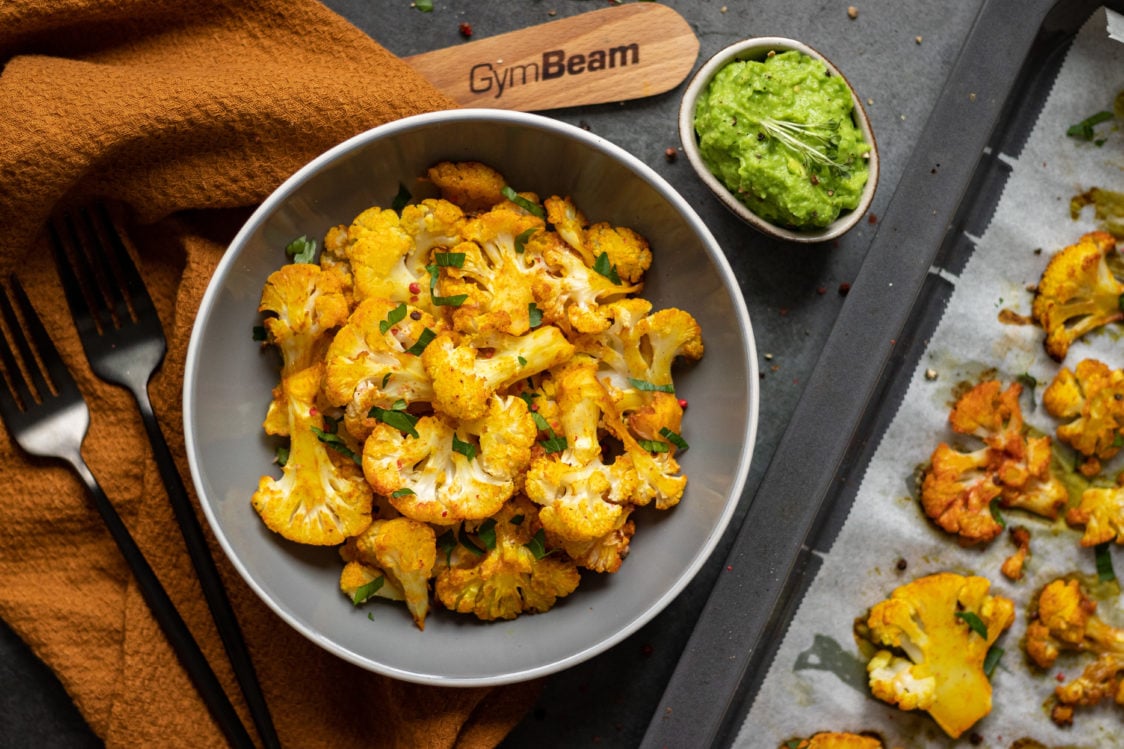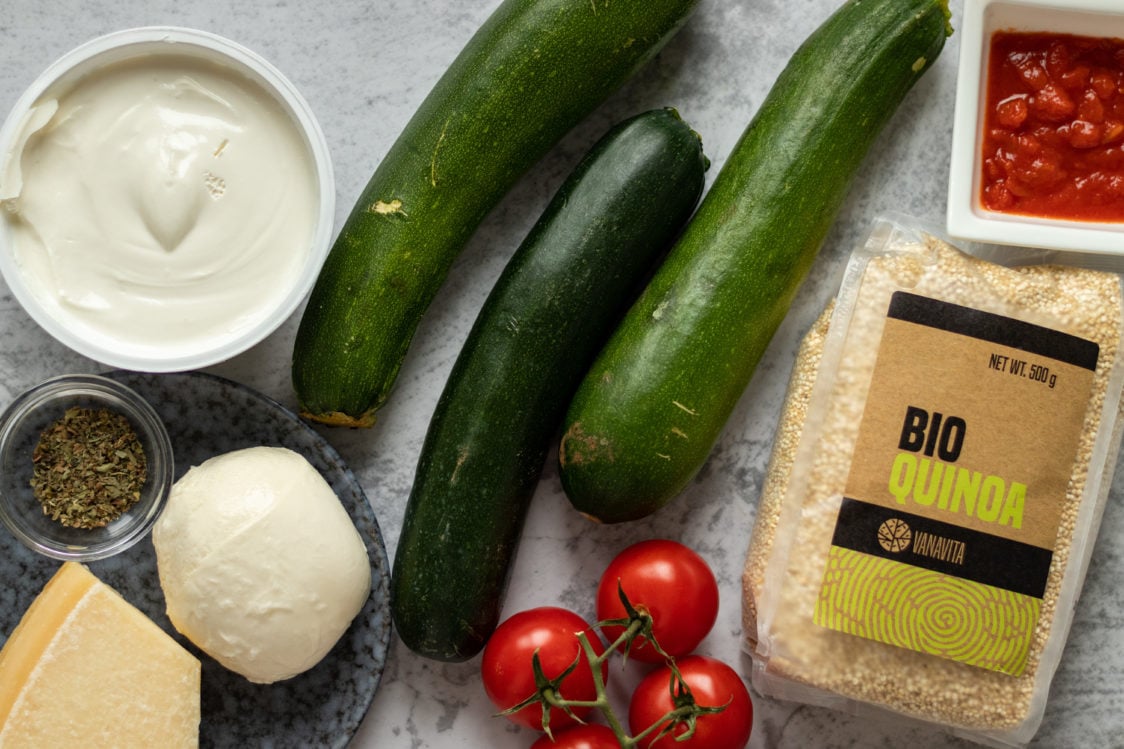Table of Contents
What do you put on your plate when you want to add some colour, flavour and vitamins to it? The answer is clearly vegetables. There are so many options and colour variations to choose from. Vegetables are an excellent source of all kinds of vitamins, minerals and bioactive compounds which are responsible for its colourfulness. Red and orange contain carotenoids, chlorophyll is behind the green colour of leaves, and for example, purple is caused by flavonoids. You will learn how individual types of vegetables can help you improve your health in today’s article.
Vegetables are not only characterised by a high content of micronutrients, but are also a good source of fibre. They have a high proportion of water and a low energy value. They can also satiate quite well, which helps with keeping the daily energy intake in check and at the same time they can increase the intake of liquids. The recommended intake of vegetables per day is 400 g, which you can imagine roughly as 1 large tomato, 1 carrot and ⅓ cucumber. It is an amount that you can easily add to your diet and you will also get around 350 ml of water from it.
1. Tomatoes
Tomatoes come from South America and are popular especially for their sweet taste and versatile use in the kitchen. Even though they belong to fruits from a botanical point of view, they are perceived and used as vegetables. They also resemble vegetables with a low amount of energy and a high proportion of water. [7]
They are a good source of vitamin C, folic acid, potassium and magnesium. Potassium, for example, affects muscle activity and regulates blood pressure, magnesium is essential for the proper functioning of the nervous system. [18]
A bioactive compound typical for tomatoes is lycopene. It is their main carotenoid, which has antioxidant effects (it fights free radicals that promote the development of cancer and other diseases). According to studies, it might have an effect on reducing the risk of prostate cancer and lowering blood pressure. The best sources of lycopene are tomato products, for example, purée, ketchup or juice (a large amount of fruit is hidden in a small amount of food). In addition, lycopene is more usable when it is heat-treated. Therefore, to get even more benefits from tomatoes, you should sauté, bake or cook them. [10,11,18]
The peel of this vegetable is rich in quercetin, which, like lycopene, has antioxidant and anti-inflammatory effects. [17,19, 21]
If you want to increase the intake of these antioxidants, you can also reach for food supplements containing lycopene or quercetin extract.
Average content of energy and nutrients in tomatoes (100 g):
| Nutritional Values and Water | Bioactive Compounds | ||
|---|---|---|---|
| Energy Value | 18 kcal | Vitamin C | 13.7 mg |
| Carbohydrates | 2.69 g | Folic acid | 15 μg |
| Proteins | 0.88 g | Magnesium | 11 mg |
| Fats | 0.2 g | Potassium | 237 mg |
| Fibre | 1.2 g | Beta-carotene | 449 μg |
| Water | 94.5 g | lycopene | 2570 μg |
Even vegetables can contain some harmful substances. Specifically for tomatoes, we are talking about tomatine. It is a glycoalkaloid found in the stems and leaves of tomatoes, as well as in green fruits. However, its adverse effects (vomiting, abdominal pain, weakness, confusion) have only been observed in animals, and it does not seem to affect humans after consuming small amounts (for example, after eating a few pieces of canned green tomatoes). Nevertheless, it is good to keep it in mind and avoid, for example, a larger amount of the green fruits. [26]
Recipes with tomatoes
Tomatoes have endless uses in the kitchen. You could try one of the following recipes:
- Pasta Salad with Cashew Dressing
- Fluffy Italian Focaccia with Tomatoes and Olives
- Breakfast Egg Muffins with Cottage Cheese, Ham and Tomatoes
- Baked Pasta with Tomato Sauce and Cheese Crust
- Lasagna with Chicken and Ricotta

2. Sweet pepper
Sweet pepper originates from Central and South America, and everyone can choose from its various types. Whether you reach for red, yellow, orange, green or white, each one will taste different and will also contain a different range of vitamins and minerals. And those who like some spice can choose chilli peppers, which also have their own health benefits.
You may be surprised to learn that sweet peppers are a better source of vitamin C than citrus fruit. Red pepper contains three to four times more vitamin C compared to lemon. 100 g of red pepper thus contains 140 mg of vitamin C (140% of the recommended daily dose of vitamin C), while lemon contains 50 mg (50% of the recommended daily dose of vitamin C). So the next time you want to support your immune system, improve collagen production or support iron absorption, choose one of the varieties of peppers. [13]
Sweet peppers are also rich in carotenoids, from which vitamin A is subsequently produced. The amount of carotenoids increases with ripening. The red pepper contains the most of them (the largest part is the carotenoid capsanthin, which is also responsible for its red colour), there is a little less in orange and yellow peppers, and the least in green peppers. These substances have antioxidant effects and thus support, for example, eye health. [8,13]
On the other hand, the carotenoid lutein is absent in red pepper, but green pepper contains plenty of it. It is also an important antioxidant and fulfils its protective role in the retina of the eye, where it protects against free radicals created by the blue light. [23]
Peppers are also a good source of potassium, vitamin K necessary for blood clotting and vitamin E, which is generally one of the most important antioxidants. [13, 19]
Average energy and nutrient content in red pepper (100 g):
| Nutritional Values and Water | Bioactive Compounds | ||
|---|---|---|---|
| Energy Value | 29 kcal | Vitamin C | 142 mg |
| Carbohydrates | 5.45 g | Vitamin E | 2.9 mg |
| Proteins | 0.9 g | Folic acid | 47 μg |
| Fats | 0.13 g | Magnesium | 13 mg |
| Fibre | 1.2 g | Phosphorus | 31 mg |
| Water | 91.9 g | Potassium | 213 mg |
| Beta-carotene | 3165 μg |
The most important component of chilli peppers is capsaicin, and the spiciness depends on its quantity. The spiciness is expressed by the Scoville scale – the hottest pepper Dragon’s Breath has a value of 2,480,000 SHU, while the famous Jalapeño has 2,500-8,000 SHU.
Capsaicin helps reduce appetite, which can play a role if you are on a reduction diet. It also supports the expansion of blood vessels and thus can participate in lowering blood pressure. Capsaicin also has anti-inflammatory and antioxidant effects and helps speed up metabolism.[15]
Recipes with peppers
How to add more peppers to your diet? You could try one of the following recipes:
- Asian Style Chicken with Quinoa
- Cold Gazpacho Soup Made from Fresh Vegetables
- Vegan Tortillas with Quinoa and Vegetables
- Baked Peppers with a Parmesan Crust

3. Spinach
If we had to pick the most popular vegetable, it would probably be spinach. You might remember how big Popeye the Sailor’s muscles grew after eating one can of spinach. Popeye helped to spread the misinformation that spinach has ten times the amount of iron compared to other types of vegetables. Iron ensures the transfer of oxygen in the body and plays an important role in our immunity.
The information about its high content in spinach was created in the 1870s, but unfortunately by mistake – by moving the decimal point. Spinach actually has a comparable amount of iron to other vegetables and it also contains a high amount of oxalates, which reduce its absorbability. Approximately only 5% of the contained iron is absorbed. [8,18]
This leafy vegetable is a good source of folic acid, which plays a very important role in the development of the nervous system and in the process of cell division. Sufficient intake of folic acid should be especially considered by women who are planning pregnancy. Spinach is also rich in vitamin C, potassium, calcium, or carotenoids. [16, 19]
Average energy and nutrient content in spinach (100 g):
| Nutritional Values and Water | Bioactive Compounds | ||
|---|---|---|---|
| Energy Value | 24 kcal | Vitamin C | 26.5 mg |
| Carbohydrates | 1.04 g | Folic acid | 116 μg |
| Proteins | 2.9 g | Calcium | 68 mg |
| Fats | 0.6 g | Magnesium | 92.9 mg |
| Fibre | 1.6 g | Potassium | 582 mg |
| Water | 92.5 g | Iron | 1.26 mg |
| Beta-carotene | 3400 μg |
Recipes with spinach
Would you like to regularly eat more spinach, but don’t know how? Here is some inspiration:
- Chicken with Pasta, Cream Sauce and Spinach
- Fit Version of French Savoury Quiché
- Savoury Waffles with Spinach and Smoked Salmon
- Savoury Spinach Pancakes Filled with Ricotta and Salmon
- Savoury Carrot and Spinach Pancakes
You might be interested in these products:
4. Carrots
This vegetable comes from South Asia and is popular mainly for its sweet taste. Also, because it has a higher sugar content than most of other vegetables, it is often used to make carrot cake.
Since you were little, your parents told you that if you want to have healthy eyes, you should eat a lot of carrots. And they were right, because thanks to the high content of carotenoids, specifically beta-carotene, carrots have a positive effect on the quality of vision. Vitamin A is produced from beta-carotene, which supports the eye health and helps to adapt the vision to see in the dark. It also affects the function of the immune system, growth, cell development, etc. [1,6,8]
Carrots are also a good source of the soluble fibre pectin. This type of fibre, in addition to supporting the proper function of the digestive tract, also helps reduce cholesterol and blood sugar levels and “feeds” the beneficial bacteria in your intestines. In addition to fibre and beta-carotene, they are also rich in potassium, vitamin K and vitamin B6. Vitamin B6 plays a key role in cell metabolism. [8, 19]
Average energy and nutrient content in carrots (100 g):
| Nutritional Values and Water | Bioactive Compounds | ||
|---|---|---|---|
| Energy Value | 42 kcal | Beta-carotene | 9938 μg |
| Carbohydrates | 7.2 g | Potassium | 280 mg |
| Proteins | 0.94 g | Vitamin B6 | 0.15 mg |
| Fats | 0.35 g | Folic acid | 37 μg |
| Fibre | 3.1 g | ||
| Water | 87.7 g |
Recipes with carrots
Stewed carrots with peas is not the only “recipe” you should rely on. Try experimenting a little:
- Baked Vegetable Chips with Cottage Cheese Dip
- Creamy Lentil Soup
- Fluffy Carrot Cake with Nuts and Vanilla Cream
- Pad Thai Noodles with Tempeh and Fresh Vegetables
- Light Lentil Salad with Roasted Carrots, Avocado and Feta Cheese
- Carrot Bread with Pumpkin Seeds

5. Cauliflower
Did you know that cauliflower florets remain white because they are covered by leaves from the sun during growth, which prevents the formation of chlorophyll? Despite this small “deficiency”, this vegetable is rich in fibre, vitamin C, vitamin K, folic acid, magnesium, phosphorus, potassium and calcium. [19]
In connection with cauliflower and other cruciferous vegetables (broccoli, cabbage, kale, kohlrabi, etc.), you may have already heard about glucosinolates, which belong to the so-called goitrogens. These are substances that “compete” with iodine in the production of thyroid hormones. In the thyroid gland, these goitrogens bind instead of iodine, which can reduce hormone production. However, you don’t have to worry about adding cauliflower to your diet causing problems. According to studies, it seems that the risk may be especially in people with a lack of iodine in the diet and with excessive consumption of foods containing glucosinolates. So if you don’t eat only cauliflower and cruciferous vegetables, you will be fine. The amount of these substances is also reduced by heat treatment. [12]
Nothing is black and white. Glucosinolates also show some positive effects on health. They have antioxidant effects and studies show a possible effect on reducing the risk of colon and lung cancer. [9]
Average content of energy and nutrients in cauliflower (100 g):
| Nutritional Values and Water | Bioactive Compounds | ||
|---|---|---|---|
| Energy Value | 26 kcal | Calcium | 25 mg |
| Carbohydrates | 2.97 g | Magnesium | 14 mg |
| Proteins | 1.9 g | Phosphorus | 44 mg |
| Fats | 0.28 g | Potassium | 299 mg |
| Fibre | 2 g | Vitamin C | 48 mg |
| Water | 92.1 g | Folic acid | 57 μg |
| Vitamin K | 15.5 μg |
Recipes with cauliflower
How to prepare cauliflower if you’re bored of just boiling it or adding it to your soups? Here are some ideas:
- Cauliflower and Broccoli Pancakes
- Roasted Cauliflower in Sweet Chilli Sauce
- Pasta with Cauliflower Alfredo Sauce
- Cauliflower Rice with Egg and Vegetables

6. Zucchini
Squash variaties, which include zucchini, come from America, but this particular variety was bred in Italy. It has a very low energy content and its value is not only in its high nutrient content, but also because of its versatile use in the kitchen.
Zucchini is rich in carotenoids, vitamin C, potassium, calcium and vitamin K. Thanks to its high water and fibre content, it can help improve digestion. [24]
The content of the so-called cucurbitacins is very important. These substances not only give zucchini its typical taste, but also have antioxidant and cytotoxic effects – they participate in the destruction of damaged cells that can lead to the development of cancer. [20]
Average content of energy and nutrients in zucchini (100 g):
| Nutritional Values and Water | Bioactive Compounds | ||
|---|---|---|---|
| Energy Value | 13 kcal | Calcium | 23 mg |
| Carbohydrates | 1.8 g | Phosphorus | 27 mg |
| Proteins | 0.8 g | Potassium | 201 mg |
| Fats | 0.1 g | Vitamin C | 12.8 mg |
| Fibre | 1 g | Beta-carotene | 205 μg |
| Water | 95.8 g |
You can prepare zucchini in many ways:
- Grated zucchini can be added to oatmeal to add some volume and an interesting texture.
- If you want to reduce the energy value of your meal, you can use grated raw zucchini as an alternative to pasta.
- Add zucchini to pancakes, patties or savoury cakes (quiche, etc.)
- You can lighten various cakes, muffins or puddings with it.
Recipes with zucchini
Zucchini has such a neutral taste that you can hide it in almost any dish. For example, try one of the following:
- Baked Zucchini with Quinoa and Cheese
- Zucchini Pancakes with Fresh Herbs
- Soft Zucchini Brownies with Chocolate
- Vegetable Pancakes with Quinoa
- Savoury Zucchini Cake with High Protein Content

7. Lettuce
Lettuce is a popular low-calorie leafy vegetable. Its typical taste is given by the acids it contains, for example citric acid or substances such as lactucin or lactopicrin. [4]
It contains a high amount of vitamin K, which is essential for proper blood clotting and proper bone mineralization. It is also a source of vitamin C, group B vitamins, folic acid, carotenoids, potassium and magnesium. [4, 25]
Be careful how you process and store lettuce. The fresher you put it on your plate, the better, because it quickly deteriorates and loses nutrients. Store it in the refrigerator for a maximum of two days, ideally wrapped in a damp towel.
Average energy and nutrient content in lettuce (100 g):
| Nutritional Values and Water | Bioactive Compounds | ||
|---|---|---|---|
| Energy Value | 16 kcal | Vitamin K | 102 μg |
| Carbohydrates | 1.4 g | Vitamin C | 4.6 mg |
| Proteins | 1.3 g | Folic acid | 59 μg |
| Fats | 0.2 g | Magnesium | 13.7 mg |
| Fibre | 1.4 g | Potassium | 253 mg |
| Water | 94.7 g | Beta-carotene | 5230 μg |
Recipes with lettuce
A bowl of salad with dressing as a side dish to your main meal doesn’t have to be the only way to prepare it. Make it special in other ways:
- Mexican Tacos with Tofu and Vegetables
- Fish Tacos Full of Balanced Flavours
- Quick Salad with Tuna, Cashew Nuts and Calorie-Free Sauce

8. Beetroot
Beetroot, commonly called chard, should appear in your diet much more often than it does. It contains a large amount of nutrients and, according to studies, it has certain specific health benefits.
Positive effects on the cardiovascular system, such as lowering blood pressure and reducing the risk of atherosclerosis are largely attributed to beetroot and beetroot juice. Drinking beetroot juice can also improve your physical performance. All the positives mentioned are related to the content of nitrates, which are converted into nitric oxide. It causes blood vessels to widen (vasodilatation) and has a positive effect on the quality of the vessel wall. Thanks to this mechanism, it can also improve sports performance, because the muscles have more oxygen and other nutrients for their optimal functioning. [2,3,14, 19]
Beetroot is also a source of minerals, mainly calcium, phosphorus, potassium, magnesium and iron. It also contains plenty of vitamin C, folic acid or carotenoids. This vegetable is definitely a superfood that would be worth rediscovering.
Average energy and nutrient content in beetroot (100 g):
| Nutritional Values and Water | Bioactive Compounds | ||
|---|---|---|---|
| Energy Value | 41 kcal | Calcium | 16 mg |
| Carbohydrates | 6.8 g | Magnesium | 23 mg |
| Proteins | 1.6 g | Phosphorus | 40 mg |
| Fats | 0.2 g | Potassium | 325 mg |
| Fibre | 2.8 g | Iron | 0.8 mg |
| Water | 87.6 g | Vitamin C | 4.9 mg |
| Folic acid | 109 μg | ||
| Beta-carotene | 20 μg |
Recipes with beetroot
Include this great food in your diet more often. Whether sweet or savoury, there are many ways to prepare it:
- Beetroot and Curd Cheese Spread
- Chickpea and Beetroot Hummus
- Beetroot Brownies with Curd Cheese Frosting
- 3 Fitness Smoothie Recipes

9. Cucumber
Like tomatoes, cucumber is also a fruit. However, its energy value does not resemble fruit at all. It has a lower amount of calories compared even to most vegetables.
Thanks to its high water content (96%), it is an ideal vegetable that can contribute to sufficient daily fluid intake. Up to 20% of the total amount of fluids comes from your meals. Foods rich in water can easily increase this number even more. Most vitamins, minerals and fibre are found in the peel, so if possible, eat cucumbers unpeeled. However, always wash them thoroughly beforehand to get rid of potentially harmful substances and microorganisms that may be on the surface.
The high water content, as well as the fibre content and very low energy value are great help in reduction diets. Cucumbers are a good source of vitamin C, folic acid, potassium and calcium. [19]
Average energy and nutrient content in cucumber (100 g):
| Nutritional Values and Water | Bioactive Compounds | ||
|---|---|---|---|
| Energy Value | 17 kcal | Calcium | 16 mg |
| Carbohydrates | 3.1 g | Potassium | 147 mg |
| Proteins | 0.65 g | Vitamin C | 13.7 mg |
| Fats | 0.1 g | Folic acid | 7 μg |
| Fibre | 0.5 g | ||
| Water | 95.2 g |
Recipes with cucumber
You don’t have to be condemned to eating just boring cucumber rolls or cucumber salad for the rest of your life. It can also be used in many other ways:
- Tuna Wrap with Avocado Dip and Vegetables
- Cold Gazpacho Soup Made from Fresh Vegetables
- Greek Vegetable Salad with Pasta
- Quick Spring Vegetable Rolls with Shrimp

10. Eggplant
Eggplant comes from the Balkans and in addition to the typical purple colour, you can also find its black, green or even red version.
Its typical purple colour is caused by flavonoids, especially the so-called delphinidin. Delphinidin, together with chlorogenic acid, is one of the main substances behind its positive effects. Thanks to them, this vegetable has an effect on the quality of the vascular wall. It also has antihypertensive effects (effect on lowering blood pressure) and also affects the level of cholesterol in the blood. Studies are also looking at its effect on lowering blood sugar and the generally positive effect on the components of the so-called metabolic syndrome (diabetes mellitus type 2, obesity, increased level of lipids in the blood, high blood pressure). [22]
Eggplant is also a good source of calcium, phosphorus, magnesium and potassium. However, you should try eating it unpeeled. By removing the skin, you would lose a large amount of the aforementioned nutrients. [19]
Never eat this vegetable raw. It contains alkaloids, such as solanine, which can cause digestive issues. However, you do not need to be afraid of heat-treated eggplant, because this process destroys the alkaloids. [5]
Energy and nutrient content in eggplant (100 g):
| Nutritional Values and Water | Bioactive Compounds | ||
|---|---|---|---|
| Energy Value | 23 kcal | Calcium | 9 mg |
| Carbohydrates | 2.9 g | Magnesium | 14 mg |
| Proteins | 0.98 g | Potassium | 229 mg |
| Fats | 0.18 g | ||
| Fibre | 3 g | ||
| Water | 92.3 g |
How to use eggplant in the kitchen?
- Cut it into slices and bake it with food of your choice.
- Cut it in half lengthwise, fill it, for example, with minced meat or other food according to your preferences and bake it.
- Use it as a stewed or roasted vegetable side dish.
- It is also good as part of baked pasta or lasagna.
- Add it to vegetable stew, pasta sauce or risotto.
- Turn it into a dip or spread.
Can you replace fresh vegetables with frozen ones?
Fresh vegetables are not always available at hand, or you just simply don’t have the time to prepare them. In that case, it is easiest to take the frozen veggies out of the freezer. And it’s okay, because frozen vegetables are not inferior in quality to fresh ones. You don’t have to worry that freezing will result in losing most of the vitamins. On the contrary, frozen vegetables retain them in relatively high quantities as freezing occurs at the stage when the vegetables are the ripest and have the highest nutrient content. You can learn more about this topic in the article Are Fresh Fruits and Vegetables Healthier than Frozen or Canned Ones?
What should you remember?
Vegetables should definitely be part of every healthy diet. They contain countless nutrients that have numerous health benefits. It is a mixture of substances with positive effects on your immunity, cardiovascular system, vision, skin, digestion, physical performance and many others. In order to get the most out of vegetables, consume the recommended 400 g per day and ideally alternate the types of vegetables so that your selection is as varied as possible.
If you liked the article and you learned something, feel free to share it with your friends so that they can learn about the TOP benefits of vegetables for their health.
[1] AHMAD, T. et al. Phytochemicals in Daucus carota and Their Health Benefits—Review Article.– https://pubmed.ncbi.nlm.nih.gov/31546950/
[2] AUTHORITY (EFSA), E.F.S. Nitrate in vegetables - Scientific Opinion of the Panel on Contaminants in the Food chain. – https://www.efsa.europa.eu/en/efsajournal/pub/689
[3] CLIFFORD, T. et al. The Potential Benefits of Red Beetroot Supplementation in Health and Disease. – https://www.ncbi.nlm.nih.gov/pmc/articles/PMC4425174/
[4] ČR, Ú. Hlávkový salát. – https://www.nzip.cz/clanek/1010-hlavkovy-salat
[5] ČR, Ú. Lilek (baklažán). In NZIP.cz.– https://www.nzip.cz/clanek/1058-lilek-baklazan
[6] ČR, Ú. Mrkev. In NZIP.cz. – https://www.nzip.cz/clanek/994-mrkev
[7] ČR, Ú. Rajčata. In NZIP.cz. – https://www.nzip.cz/clanek/1020-rajcata
[8] DUYFF, R.L. Complete Food & Nutrition Guide. – https://www.amazon.com/Academy-Nutrition-Dietetics-Complete-Guide/dp/0544520580
[9] HIGDON, J.V. et al. Cruciferous Vegetables and Human Cancer Risk: Epidemiologic Evidence and Mechanistic Basis. – https://pubmed.ncbi.nlm.nih.gov/17317210/
[10] CHEN, P. et al. Lycopene and Risk of Prostate Cancer. – https://www.ncbi.nlm.nih.gov/pmc/articles/PMC4616444/
[11] CHENG, H.M. et al. Tomato and lycopene supplementation and cardiovascular risk factors: A systematic review and meta-analysis. – https://pubmed.ncbi.nlm.nih.gov/28129549/
[12] LÓPEZ MORENO, M. et al. Antinutrients: Lectins, goitrogens, phytates and oxalates, friends or foe?– https://www.sciencedirect.com/science/article/pii/S1756464622000081
[13] MATSUFUJI, H. et al. Anti-oxidant content of different coloured sweet peppers, white, green, yellow, orange and red (Capsicum annuum L.): Anti-oxidant content of coloured sweet peppers. – https://ifst.onlinelibrary.wiley.com/doi/10.1111/j.1365-2621.2006.01368.x
[14] ORMSBEE, M. et al. Beetroot juice and exercise performance. – https://www.dovepress.com/beetroot-juice-and-exercise-performance-peer-reviewed-fulltext-article-NDS
[15] PANCHAL, S.K. et al. Capsaicin in Metabolic Syndrome.– https://www.ncbi.nlm.nih.gov/pmc/articles/PMC5986509/
[16] SAINI, R.K. et al. Folates: Chemistry, analysis, occurrence, biofortification and bioavailability. – https://www.sciencedirect.com/science/article/abs/pii/S0963996916302897
[17] SALEHI, B. et al. Therapeutic Potential of Quercetin: New Insights and Perspectives for Human Health.– https://www.ncbi.nlm.nih.gov/pmc/articles/PMC7254783/
[18] SPOLEČNOST PRO VÝŽIVU Referenční hodnoty pro příjem živin. – https://search.mlp.cz/cz/titul/referencni-hodnoty-pro-prijem-zivin/3762758/#/getPodobneTituly=deskriptory-eq:3864011-amp:key-eq:3762758
[19] USDA FoodData Central.– https://fdc.nal.usda.gov/
[20] WANG, X. et al. Cucurbitacins: elucidation of their interactions with the cytoskeleton. – https://www.ncbi.nlm.nih.gov/pmc/articles/PMC5452965/
[21] XU, D. et al. Antioxidant Activities of Quercetin and Its Complexes for Medicinal Application. – https://pubmed.ncbi.nlm.nih.gov/30901869/
[22] YARMOHAMMADI, F. et al. Effect of eggplant (Solanum melongena) on the metabolic syndrome: A review. – https://www.ncbi.nlm.nih.gov/pmc/articles/PMC8143715/
[23] Bezpečnost potravin A-Z. – https://www.bezpecnostpotravin.cz/az/termin/92522.aspx
[24] Cuketa | Nutridatabaze.cz. – https://www.nutridatabaze.cz/potraviny/?id=52
[25] Salát hlávkový | Nutridatabaze.cz. – https://www.nutridatabaze.cz/potraviny/?id=73
[26] α-Tomatine and other steroidal glycoalkaloids in fruits of tomato lines resistant to the glasshouse whitefly (Trialeurodes vaporariorum West).– https://link.springer.com/article/10.1007/BF00041502

